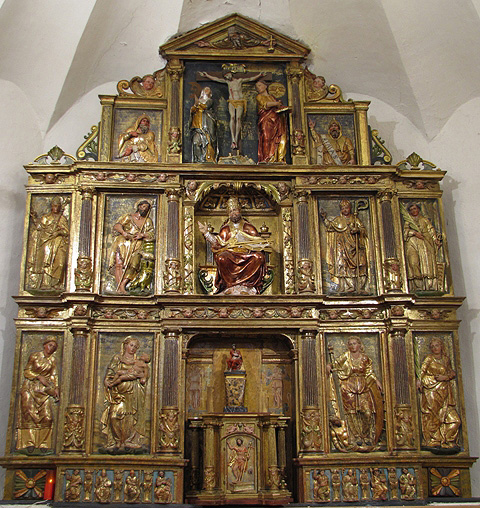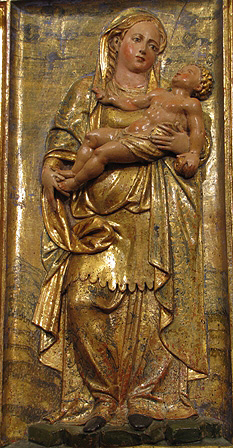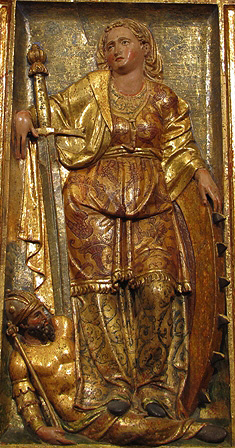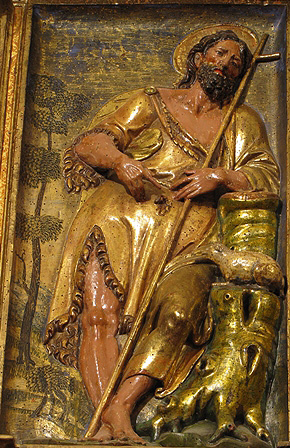The piece of the month of December 2011
THE MAIN ALTARPIECE OF LERATE AND THE TRANSITION BETWEEN THE TWO RENAISSANCES IN THE WORKSHOP OF VILLANUEVA DE ARAQUIL
Pedro Luis Echeverría Goñi
Chair of Navarrese Heritage and Art
The main altarpiece of the parish of San Pedro de Lerate is a little-known example of early Mannerism in Navarre, executed at the beginning of the decade of the 70's of the 16th century and represents in a model way in its design, decoration, reliefs and carvings, still expressive, the moment prior to Romanism, which would be imposed throughout the Kingdom in the last two decades of the century. This work began during the bishopric of Diego Ramírez Sedeño de Fuenleal, who in 1562 had attended the sessions of the Council of Trent. Exceptionally, it preserves its original tabernacle, a beautiful polychrome with fantastic Mannerist estofados and the Eucharistic themes executed at the tip of the brush inside the tabernacle. Its importance increases if we consider that its authors, the carver Juan de Elordi and the painter Martín de Miranda were representative members of the unpublished workshop of Villanueva de Araquil. Repainted at the end of the 19th century, the altarpiece recovered its original polychromy in the restoration carried out in 2002 by Joaquín Martinena, and a later display was removed at the same time.
Its origins are in a mandate of visit of 1570, by which Dr. Alquiza ordered its manufacture, since the church only had a "stone relic...with its grille and key" and had sufficient resources to pay for it. It specified that the altarpiece should be "of carving and imagery", "warped as is the same wall" to adapt it to the octagonal chancel, reserved the choice of "the vocations of the same", that is, the iconographic program to the abbot and patrons, and set a price of no more than 150 ducats. After the licence, two contracts were made for its execution in 1570 and 1571 with Juan de Elordi, carver of Villanueva de Araquil, and in 1575, once it was finished and settled, it was appraised by Juan de Villarreal, overseer of works of the bishopric, at 200 ducats. In some of its best high reliefs we see the hand of the image maker Friar Juan de Beauves, who usually collaborated in the altarpieces assumed by this carver. Then its polychrome complement was made by Martín de Miranda, a painter from the same town of Araquil and son-in-law of Elordi, between 1575 and 1577, when the aforementioned Guipuzcoan overseer estimated the gilded and stewed work at 230 ducats, in another example of the overpricing of the polychrome in relation to the carved work. Between 1579 and 1590, his widow María de Elordi and her heirs, such as the sculptor Miguel Marsal, collected the outstanding sums, with the final payment to Miranda's widow for the gilding in 1592.
In the Araquil, Barranca and Burunda corridor, which connected the kingdom of Navarre with Castile and the Llanada of Alava, the thriving retablistic workshop of Villanueva de Araquil was established, united from 1540 and during the second half of the 16th century by the presence of family clans with endogamous ties such as the Landa family (Juan I, assembler, his son Pedro (+ 1575), image maker and assembler, and his grandsons Juan mayor, sculptor (c. 1569-1611), and Juan menor, painter-decorator (c. 1569-1611). 1569-1611), and Juan minor, painter-decorator), the Marsals (Maese Miguel Marsal de la Gullada, mason, his son Juan, carver (c. 1540-1563), his grandson Miguel Marsal (+ 1593), assembler and carver, and Pedro, of the same official document) and the Elordi or Villanueva (Juan, carver (c. 1543-1573), Martín and his son Juan, also carvers). Juan de Landa I was son-in-law of Miguel Marsal de la Gullada; Juanes de Elordi was father-in-law of the painter Martín de Miranda; Miguel Marsal was the heir of Pedro de Landa and Juan de Elordi. Other localities in which masters of the stature resided were Huarte-Araquil (Pierres Picart, Lope de Larrea and fray Juan de Beauves), Alsasua (Juan de Madariaga) or Olazagutía (Miguel de Elizalde).
The relationship between the French carver Pierres Picart de Perona and Juan de Elordi and his son-in-law Martín de Miranda, expressed in the transfer of the polychromy of the altarpieces of Huarte Araquil in 1572, may be of great importance, yet to be appreciated, "in view of the good and pleasant services and pleasures that...you have given me and I hope that from here you will give them to me". Juan de Elordi's prolific period is between 1558 and 1575, with the main altarpiece and side altars of the parish of Vidaurreta standing out among his works. We know that in 1575 the image maker Friar Juan de Beauves was residing at Shrine of Our Lady of Fair Love of San Salvador de Villanueva de Araquil, making carvings and high reliefs for masters of this workshop such as Juan de Elordi, with whom he collaborated in the Vidaurreta altarpieces (main altarpiece and that of Santa Barbara) and in this one in Lerate. All the documented works of Martín de Miranda (Huarte-Araquil, Hernialde ("brush boards"), Arguiñáriz and Lerate) correspond to the decade of the 70's of the 16th century in a market that, like the carvers and sculptors of Villanueva de Araquil, exceeds its natural market, the valley of the Araquil, surpasses its natural market, the Araquil valley, to enter through the south in localities of valleys such as Guesálaz, Ollo, and Goñi, and through the north in Guipúzcoa, where he collaborated with the French painter Juan de Breheville, neighbor of Motrico.

Main altarpiece of Lerate
In spite of what was indicated in the mandate of visit, the altarpiece of Lerate sample in its layout is a flat development , although the recessing of the narrower extreme streets makes the three central ones stand out. It consists of a reduced bench, two sections, punctuated by five lanes and an attic with another three lanes. This is a pigeonhole altarpiece compartmentalized in eight panels with high reliefs, concentrating the four carvings in the central street. Structurally, there is a peculiar superposition of orders, Ionic in the hermes of the bank and in the columns of the first body, reserved for the Virgin and the saints, and Corinthian in the second, occupied by St. Peter and saints. Also characteristic of the end of the second quarter of the 16th century are the classical columns with fluted shafts and carved third and the carpanel arches of the central street, the arch of the main body, with foliated and correiform borders, and coffers with flowers inside. As usual, in the attic we see the only pediment of the whole and to the double volute finials, cherub heads are added in the central street of the attic.
It conserves its original tabernacle or reliquary of semi-hexagonal plan with Ionic columns of third carving and pilasters of the same order in correspondence. In its door is represented Christ resurrected, Trentine iconography that is repeated in other altarpieces of the beginning of the decade of the 70's of the XVI century like those of Yábar, Urroz Villa or Ochagavía. It lacks the original expositor, replaced at the end of the 19th century, by another modern one with doors, which has also been removed in the last restoration. A small Mannerist carving of the Ecce Homo, which was removed from the sacristy, has been placed on the tabernacle, reintegrating it to the piece of furniture to which it originally belonged.
Its decorative repertoire, already refined and reduced, is characteristic of fantastic mannerism with motifs that are concentrated in specific frames of the altarpiece. Among these we recognize hanging cloths, cornucopias, masks, little angels and correiform cartouches on the carved thirds of the columns, pendants with strings of leaves, ribbons, harnesses and keys on the pilasters and little heads of angels linked by cloths and garlands on the friezes. Particularly interesting are the motifs of the bench with male hermes with Ionic capitals on the gospel side and caryatid hermes of the same order on the epistle side (their breasts, which had been scraped off, have been reintegrated in the last restoration). It seems that these anthropomorphic supports or small-scale terms were a specialization program of the carver Juan de Elordi, as they are repeated in other of his works such as the bench of the main altarpiece of Vidaurreta, and of other masters of the transition period in the 1970s, such as Miguel de Espinal in the benches of the main altarpieces of Urroz Villa and Ochagavía, also framing reliefs of saints, or Pierres Picart and Friar Juan de Beauves in the side altarpieces of the Virgin of the Rosary and San Ginés de Irañeta. However, the most varied representation in issue and typologies of male and female hermes was carved in stone and is located in the balustrade of the choir of the parish of Torralba del Río, a work directed from 1574 by the stonemason Juan de Aguirre.
Although we know of a series of hermes engravings by Agostino Veneziano (1536) and Cornelis Bos (1546), the frontispiece of the Spanish translation of Books III and IV of Architecture by Sebastiano Serlio by F. Villalpando (1552), which was owned by some of the most illustrious patrons of our Renaissance such as the archdeacon Remiro de Goñi, the Calaguritan bishop Juan Bernal Díaz de Luco and the treasurer Martín de Mezquita, had a greater impact in our land. These anthropomorphic stipes were first copied in editions of books by Adrián de Amberes in Estella and in the cover of the General Hospital of Nuestra Señora de la Misericordia in Pamplona (1556), where we see two hermes carved by the carvers Juan de Villarreal and Juan Vizcaíno. From the middle of the century is the Casa del Almirante in Tudela, which sample on its façade these anthropomorphic supports with Hercules between Lust and Abundance. In 1556 Martín de Mezquita commissioned the grille and the altarpiece of the chapel of San Martín in the cathedral of Tudela, both works in which we see several carved, carved and painted hermes. Also in 1556 the main altarpiece of the parish of La Magdalena in the capital of La Ribera was valued, a work by Domingo de Segura, where among other early mannerist motifs, we find hermes distributed along the bench.

Main altarpiece of Lerate. Virgin and Child
The iconographic program, with the "vocations" chosen by the abbot of Lerate, begins on the bench, where we see symbolically the foundations of Christian doctrine, the evangelists and the Fathers of the Church. Flanked by hermes, St. Mark, St. Ambrose, St. Gregory the Great and St. Matthew, on the Gospel side, and St. John, St. Augustine, St. Jerome and St. Luke, on the Epistle side. In the central street are superimposed the tabernacle, St. Peter Pope, and Calvary, under the gaze of God the Father. In the first body of marked feminine character, the relief of the Virgin with the Child stands out, located in a preferential zone to the right of the tabernacle, and she is accompanied by Mary Magdalene, Saint Catherine of Alexandria and Saint Lucia. In the second body escort the titular, San Blas, bishop of Sebaste, and San Juan Bautista in the side of the gospel and San Martin, as bishop of Tours, and the deacon San Lorenzo in that of the epistle. Thus, it is a hagiographic altarpiece in which specific devotions are highlighted, the authority of the first Pope appointed by Christ is affirmed, the culmination of the Redemption is represented with Calvary and the Paschal triumph with the Resurrection of the tabernacle. The two Attic prophets, identified by phylacteries as Isaiah and Jeremiah, prefigure and guarantee the continuity between the two Testaments.
In general lines the carvings and high reliefs of the altarpiece of Lerate are works of expressive style for their rafaelesque models, elongated canon, hands of long fingers and clothes glued to the body of very worked folds, standing out the reliefs of the Virgin with the Child, San Juan Bautista and Santa Catalina, that denote the hand of fray Juan de Beauves. The elegant figure of the Virgin holds a Child of marked Anatomy announcing already prototypes of Romanism, that we already see in the children or "chicotes" leaning on the door of the tabernacle and facing a chalice with the Form, that remind us of the allegories of the Medicean Tombs. The same entity is seen in the relief of Saint Catherine, with a short chin and powerful neck, revalued in this case by its elaborate and well-preserved polychromy; the figure of Maxentius, reclining at her feet, reminds us in its iconography of Jesse. On the door of the tabernacle there is a relief of the risen Christ that, although its stylistic features are expressive, it already offers us a triumphant counter-reformationist iconography. Although hidden from view, the high reliefs of St. Peter and St. Paul show an elongated canon and denote the gouge of a good image maker. Also worthy of note are the relief of St. John the Baptist, an ascetic figure with high cheekbones, locks on the forehead, long fingers and expressive crossing of the legs that are signatures of the Friar's style, and the small carving of Ecce Homo, which sample an elegant mannerist contrast between the grandiloquent twists of legs and arms. The agonizing Christ of Calvary repeats the outline of others executed by Friar Juan de Beauves such as those of Huarte Araquil and Alsasua. The carving of St. Peter represents him as pope in Chair with an open book on his left leg and blessing. The two keys that were added to this carving have been placed over the book. The Chair is especially well cared for, in which we see the seat with foliated avolute edges and the back with two Tuscan pilasters with fluted shafts and as a crowning touch, a vener between two vases.
We find ourselves before an altarpiece that exclusively houses isolated figures in high relief that represent specific local devotions, very much in demand in the 16th century. Going over its surface we can see the repetition of some gestures and attitudes, such as the frontality and isocephaly of the Evangelists and Fathers of the Church, characteristic of Juan de Elordi, who are lined up seated between hermes on the bench. The end interspaces, probably added to the initial plan, show some high reliefs that repeat their disposition according to their location in the altarpiece. Thus, Saint Blaise appears, like Saint John the Baptist, leaning towards the central street, with the same gesture of the left hand on the chest and holding his attribute, the crosier, diagonally, as does the Precursor with the cross. St. Catherine and St. Lucy also make a similar gesture with their right hands holding the sword and palm respectively. Only the Magdalene and the Virgin and St. Martin and St. Lawrence adopt different postures according to their iconographic peculiarities. Isaiah and Jeremiah cover their heads with hoods and point towards the Crucifixion, which had been prophesied by the former (Isaiah, 53,12).

Main altarpiece of Lerate. Santa Catalina
This altarpiece is enhanced by the contemporary polychromy done by Martín de Miranda, Elordi's son-in-law, once the carving work was completed, although it is quite deteriorated. The gilding generously floods all the surfaces, even improper areas such as the Baptist's tree, facilitating the distension of the employment of corlas and diverse works. Among the motifs made at the tip of the brush, two slender Mannerist angels with the cane and the spear stand out, which, together with dynamic fabrics, flanked the exhibitor. On the inner sides of this same box we see two figures with striking blue tunics holding up correiform cartouches with hanging cloths. Beautiful stewed decorations decorate garments such as the red surcoats of Saint Catherine and the Magdalene, with fantastic birds, cornucopias with fruits and ribbons; on the greenish tunic of the saint of Alexandria we also see stylized bouquets. Other motifs are the undulating fabrics and stems in whose rhythm nude boys are interspersed in the dalmatic of St. Martin and in the mantle of St. Lucy, as well as in the tunic of St. Peter and the mantle of St. Paul in the tabernacle. The sgraffito areas of the altarpiece are the most deteriorated, such as some backgrounds decorated with geometric motifs (Saint Lucia and the Magdalene) or landscapes with linear planes (Virgin). Better preserved are the sgraffitoes with a soldier whipping the martyr in the relief of San Lorenzo and a library assistant of grotesques in a blue field that decorates a pilaster next to Isaiah. The friezes of the tabernacle box and the recesses of the pilasters are also decorated with scrolls and Moorish engravings on a red background. St. John the Baptist is placed in the "desert" thanks to a beautifully painted landscape, in which a long tree with several open graphite fronds stands out. The original matte incarnations, very nuanced, as well as the painting or gilding of the hair, recovered in the last restoration, allow a better evaluation of the profiles of the carving. However, the images of the patron, together with the Virgin and St. John of Calvary, which had been repainted with natural cloths, have been silvered, gilded and corolated in 2002.

Main altarpiece of Lerate. Saint John the Baptist
However, where the mastery of this painter-decorator is best appreciated is in the brushstrokes executed on the gilding in the protected interior of the tabernacle. On the back of the door we see the Veronica who sample the cloth with an enormous Holy Face of Christ, with its greenish crown of thorns. On the back panel there is a symmetrical composition in which two angels hold on a cloth a chalice with Gothic elements of polygonal base and concave sides, spherical knot, bell-shaped cup and foliated sub-cup with the Form. Escorting this Eucharistic topic in the side panels are two other Passion angels, one with the reed and sponge and spear, and the other with the high column of the Flagellation. They are mannerist figures of elongated canon and showy tunics of studied folds. Their tunics and wings alternate bright shimmering red, blue, yellow and violet colors. The ceiling simulates the sky with a blue background dotted with golden stars.
Documentary sources
AD. Pamplona. Parish archives. Lerate. Libro de visitas y cuentas de fábrica from 1541 to 1640 (box 36, nº 4), fols. 56v-59 (carving work) and 60-61v, 63v-64v and 68-77v (gilding and estofado).
AGN. Prot. Not. Salinas de Oro, Juan de Salinas, 1570. Agreements between the place of Lerate and Juan de Elordi. Invº S/R. Ibid, 1571. Agreements about the altarpiece of Lerate. Inv. S/R.
AGN. Prot. Not. Villanueva de Araquil. Juan Mendívil, 1572, nº 42. Assignment of Pierres Picart in favor of Martín de Miranda.
bibliography
GARCÍA GAÍNZA, Mª C. and others, Catalog monumental de Navarra, T. II**.Merindad de Estella, Pamplona, Príncipe de Viana, 1983, pp. 109-110.
ECHEVERRÍA GOÑI, P. L. and FERNÁNDEZ GRACIA, R., "El imaginero fray Juan de Beauves", conference Nacionales sobre Renacimiento español. CEHA, Príncipe de Viana (1991), annex 10, pp. 161-170.
ARRAZOLA ECHEVERRÍA, Mª A.: Renaissance in Guipúzcoa. T. II. Sculpture. San Sebastián, Diputación Foral de Guipúzcoa, 1988, p. 341.
